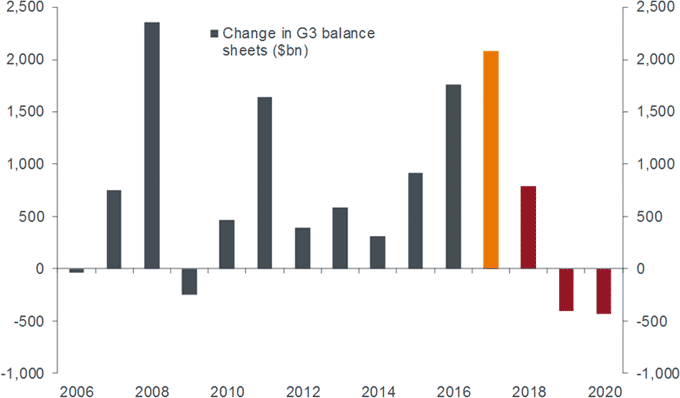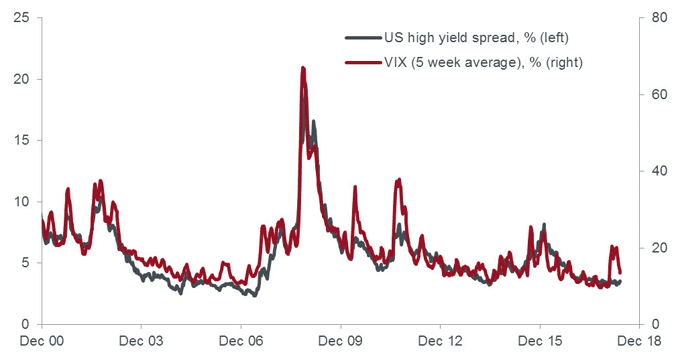
Janus Henderson: Multi-Asset - expect surprises, expect volatility
Paul O’Connor, Head of Janus Henderson’s UK-based Multi-Asset Team, outlines his view on the events of 2018 thus far and gives his outlook for different asset classes.
18.06.2018 | 13:38 Uhr
Quantitative easing peaks, volatility troughs
We see 2018’s upshift in financial market volatility as a return to more normal market conditions, following one of the most tranquil years in market history. The unusually benign market environment of 2017 reflected a remarkably favourable macro backdrop. It was a year of sustained positive global growth surprises, yet with limited upward pressure on inflation and interest rate expectations. It was also a year in which global central banks poured $2,000bn into financial markets through their quantitative easing (QE) programmes – the biggest annual injection since 2008 (chart 1).This year looks very different. Markets are notably more turbulent. This reflects the fact that investors have begun to realise that the near-perfect macro conditions of 2017 and early 2018 cannot last forever and are now adjusting expectations towards an environment that will be more complicated, more uncertain, and more ‘normal’.
Chart 1: central bank asset purchases (QE)

Source: JP Morgan as at March 2018, 12-month changes in US dollars (billions). Red bars denote JPM forecasts. Orange bar = 2017. G3 central banks = US Federal Reserve (Fed), European Central Bank, Bank of Japan. Chart is for illustrative purposes only.
Solid macro fundamentals
We retain our constructive view on global macro fundamentals, believing that the global economic expansion has the potential to be unusually long by historical standards, underpinned by exceptionally low real interest rates in all the major economies. Even though the rate cycle is already on the turn, led by the US, the speed and scale of tightening that we anticipate from the major central banks looks unlikely to derail the global recovery.It might seem incongruous to have a fairly cautious view on many of the major asset classes while holding a positive view on the macro outlook but this is where we find ourselves right now. As we wrote in January (in “Fade the surge”), we were concerned that financial markets then were fully pricing in the most optimistic macro outcomes and taking little account of a number of plausible risk scenarios. We raised cash in our multi-asset funds. Since then, investors have indeed begun to confront and price in a seemingly unending number of different concerns. This has included the threat of higher US inflation and a more aggressive Fed rate-hiking cycle, regulatory risk in the technology sector, global trade tensions, and a range of country-specific troubles stretching from Korea to Argentina, Turkey, Italy and Spain.
A rational repricing of risk
At this stage, we do not regard any of these issues as being big enough to meaningfully affect global macro fundamentals. However, they have been big enough to rattle financial markets. Theme by theme, investors have been reminded of the need to at least consider some threats to the highly positive consensus macro outlook that prevailed at the start of the year. In broad terms, we see what is happening here as being a rational repricing of risk – a healthy resetting of investor expectations from complacency to a more balanced evaluation of both upside and downside scenarios.In most of the major asset classes, we believe that this repricing of risk is incomplete. We expect markets to remain choppy in the months ahead as investors weigh up the various conflicting influences that are now in play. The volatility that we anticipate will at times be a source of discomfort for investors, but it will also be a source of opportunity for dynamic asset allocation. As we approach mid-year, we are still well invested in financial markets in our multi-asset funds, but not fully. We have some cash held back to give us scope to buy dips if assets do become more attractively priced.
Buying dips in equities – staying patient in credit
Equities remain our strategically favoured asset class. Although the bull market is now well advanced by historical standards, the prospect of an unusually long economic expansion does provide fundamental support for further gains in stocks. Still, given the changing global monetary environment, and the various specific challenges discussed above, we see the volatile, lowish-return, equity market conditions of the year so far as being a good guide to what the rest of the year holds. Whereas, in most assets, the dips we have seen so far this year have not been big enough to tempt us, the one exception was the double-digit pullback in the FTSE 100 Index in Q1.We continue to struggle to find value in fixed income. In government bonds, we expect real yields to keep trending higher, reflecting the ending of QE, the turn in the global rate cycle and the continued expansion of the global economy. We are happy to start reducing our underweight in government bonds by buying 10-year US Treasuries when yields exceed 3% but are not in a hurry right now, here or anywhere else in the government bond market.Elsewhere in fixed income, our caution regarding investment grade corporate bonds this year has served us well. It has been the worst performing of all of the major asset classes so far in 2018. While the same factors behind our wariness on government bonds were key considerations, we also felt that the spreads of investment grade yields over sovereign bonds were just too low. Although spreads have now begun to widen – a good example of a much-needed risk repricing – valuations are not yet sufficiently attractive to encourage us to change our stance. We remain on the cautious side of neutral on high yield bonds as well. Our macro outlook is still supportive of the asset class given the possibility of a prolonged era of low defaults, but that seems to be fairly well priced in already. Valuations have improved a bit in recent weeks but not enough to encourage us to add to positions.
Chart 2: high yield debt spreads and equity implied volatility (VIX)

Source: Bloomberg, CBOE Volatility Index (‘VIX’) data from December 2000 to May 2018. The VIX is averaged over five weeks. For the US high yield market the spread differential is between US 10-year Treasuries and the Barclays US High Yield Index. Chart is for illustrative purposes only.
What could go wrong?
As discussed above, there are of course a number of significant risks to our market outlook. While it is encouraging to note how resilient the global recovery has been to adverse shocks this year, any comfort on this front must be counterbalanced by the recognition of its structural frailties. Many features of the global macro environment are unprecedented, such as the amount of debt and the size of central bank intervention. Accordingly, the impact of shocks is hard to calibrate. We have to stay vigilant and flexible. At this stage, our attention is focused on the following three key risks:
- Economics: the most credible macro threat to our continued long-cycle scenario would be if inflation expectations lifted so much as to compel central banks to normalise monetary policy more urgently. While recent data still support our view that the recovery in global inflation will be gradual, we continue to monitor developments on this front closely, as a sustained increase in inflation expectations would be a game-changer for financial markets.
- Policy: the threat of a continued escalation in global trade tensions looms as a plausible risk to economic and market stability. Concern focuses as much on the US-EU relations as those between the US and China. While it remains difficult to predict how these politically-charged negotiations will evolve, our core view for now is that economic logic and corporate lobbying will ultimately guide leaders away from outcomes that damage the global expansion.
- Politics: Italy is the big worry here. The recently formed government is a fragile coalition of two parties that are not natural partners. It is hard to predict where they will take policy, but it is likely to be in a direction that puts Italy on a collision course with both the EU and financial markets. The constructive view is that the prospect of financial market turbulence will impose some discipline on policy and the new Italian government can find common ground with the EU in areas such as immigration and border control. However, more disorderly outcomes remain highly plausible and the situation needs to be watched closely.
Expect surprises – expect volatility
Summing up, we still see the global backdrop as being in a transition phase, away from the exceptional macro conditions of 2017, towards a more complicated, uncertain and normal environment going forward. Investors will need to adjust to more frequent swings in sentiment and less stability in markets. However, even if things work out well, we still expect relatively modest returns from most asset classes over the course of this year. The era of easy buy-and-hold investing is over; we believe this is a time for active asset allocation. Expect surprises – expect volatility.




Diesen Beitrag teilen: